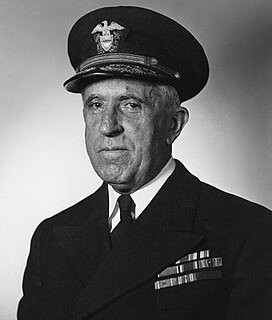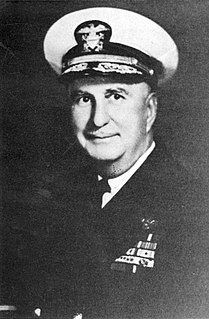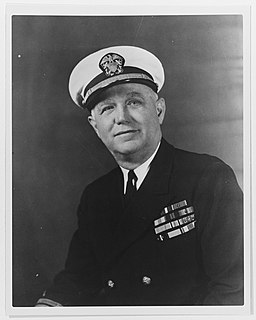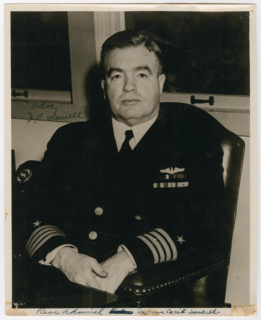
Edward Walter Eberle was an admiral in the United States Navy, who served as Superintendent of the United States Naval Academy and the third Chief of Naval Operations.

William Robert Munroe was a decorated officer in the United States Navy with the rank of Vice Admiral. He trained as submarine commander and at the beginning of World War II, he served as Commander, Battleship Division 3 during Neutrality Patrol in the Atlantic ocean.

John Herbert "Babe" Brown, Jr. was a decorated officer in the United States Navy with the rank of Vice admiral during World War II and an American football player. A graduate of the United States Naval Academy, Brown trained as submariner and served successively as Commander, Submarine Squadron 4 and Commander Training Command, Submarine Force, Pacific Fleet in the opening years of World War II. Brown was then promoted to Rear admiral and commanded Cruiser Division One during the bombardment of Japan in summer 1945.

Oliver Owen Kessing was a highly decorated officer in the United States Navy with the rank of Rear Admiral. A veteran of several conflicts, he rose to the rank of Commodore during World War II and commanded several Naval Bases in South Pacific area.

Carl Frederick Holden was a decorated officer in the United States Navy who reached the rank of Vice Admiral. A veteran of both World Wars, he became an expert in Naval communications, graduating with Master's degree in electrical communications from the Harvard University. Holden served as Director of Naval Communications between September 1942 - April 1943 and distinguished himself as commanding officer of battleship USS New Jersey, the flagship of Admiral William F. Halsey. He rose to the admiral's rank in 1945 and commanded Cruiser Division 18 in late phase of the World War II.

Herbert Fairfax Leary was a highly decorated officer in the United States Navy with the rank of vice admiral. A son of Rear Admiral Richard P. Leary, he distinguished himself during World War I while on the staff of Commander, U.S. Naval Forces in Europe under Admiral William Sims and received the Navy Cross, the United States Navy's second-highest decoration awarded for valor in combat.

Rear Admiral Spencer Shepard Wood was a United States Navy officer. His career included service in the Spanish–American War and World War I, command of battleships and cruisers, and duty as an aide to a number of senior naval leaders.

Harry Bean Jarrett was a highly decorated officer in the United States Navy with the rank of Vice Admiral. A veteran of several campaigns in Pacific during World War II, he distinguished himself during the Battle of the Coral Sea in May 1942, while commanding destroyer Morris and received the Navy Cross, the second highest decoration of the United States military.

Henry David Cooke Jr. was a highly decorated officer in the United States Navy with the rank of Rear admiral. A graduate of the United States Naval Academy and veteran of several conflicts, he was wounded during the Philippine–American War and later distinguished himself as Commanding officer of destroyer USS Allen during World War I for which received the Navy Cross, the second highest decoration of the United States military awarded for valor.

Charles Perry Mason was a highly decorated officer in the United States Navy with the rank of Vice admiral. An early naval aviator, he distinguished himself as Commanding officer of aircraft carrier USS Hornet (CV-8), which was sunk during the Battle of the Santa Cruz Islands in late October 1942. Mason was subsequently promoted to Rear admiral and served successively as Commander, Aircraft, Solomons and Chief of the Naval Air Intermediate Training Command at Naval Air Station Pensacola, Florida.

Francis Stuart Low was a decorated officer of the United States Navy with the rank of four-star Admiral. An expert in submarine warfare, Low is credited with the idea that twin-engined Army bombers could be launched from an aircraft carrier. This idea was later adopted for the planning of the Doolittle Raid.

Frank Dechant Wagner was a highly decorated Naval aviator in the United States Navy with the rank of Vice Admiral. A Naval Academy graduate, Wagner distinguished himself as Commander of Patrol Wing Ten during operations against the enemy in the early weeks of the Japanese Invasion of the Philippines. He was then promoted to the general officer's rank and served as Commander, Aircraft, Seventh Fleet during liberation of the Philippines in 1944–1945.

Carleton Fanton Bryant was a highly decorated officer in the United States Navy with the rank of Vice Admiral. He distinguished himself as Commander of the Gunfire Support Group of the Assault Force "O" during the amphibious invasion of the coast of Normandy, France, on June 6, 1944.

Glenn Benson Davis was a highly decorated officer in the United States Navy with the rank of Vice Admiral. He distinguished himself as Commanding officer of battleship USS Washington during the Naval Battle of Guadalcanal in November 1942, when Washington sank the japanese battleship Kirishima.

John Franklin Shafroth Jr. was a highly decorated officer in the United States Navy with the rank of Vice Admiral. He distinguished himself as Commander of destroyer USS Terry during World War I and received the Navy Cross, the United States Navy second-highest decoration awarded for valor in combat.

Laurance Toombs DuBose was a highly decorated officer in the United States Navy with the rank of four-star Admiral. A veteran of several conflicts, including both World Wars, he distinguished himself several times as Commanding officer of heavy cruiser USS Portland and Commander, Cruiser Division 13 in the Pacific theater of World War II and received three awards of Navy Cross, the United States Navy second-highest decoration awarded for valor in combat.

Ingram Cecil Sowell was a highly decorated officer in the United States Navy with the rank of Rear Admiral. A graduate of the United States Naval Academy, he was trained as submarine commander and distinguished himself as Commanding officer of submarine USS K-2 during World War I and received Navy Cross, the United States Navy second-highest decoration awarded for valor in combat.

William Ward Smith was a decorated officer in the United States Navy with the rank of Vice Admiral. A graduate of the Naval Academy and participant of several conflicts, he distinguished himself during World War II as Commander, Cruiser Task Force during the Battles of the Coral Sea and Midway in May and June 1942.

Howard Hartwell James Benson was a highly decorated officer in the United States Navy with the rank of Commodore. A son of Chief of Naval Operations, Admiral William S. Benson, he distinguished himself as Commanding officer of destroyer USS Roe during World War I and received Navy Cross, the United States Navy second-highest decoration awarded for valor in combat.

Roland Nesbit Smoot was a highly decorated officer in the United States Navy with the rank of Vice admiral. A graduate of the United States Naval Academy, he distinguished himself several times during his service with destroyers in Pacific and was decorated with two Navy Crosses, the United States Navy second-highest decoration awarded for valor in combat.




















